|
Third Battle of Winchester, Virginia, Civil
War History
Introduction
With a combined 8,600 casualties, the 3rd Battle of Winchester was the most
important of the many engagements fought during the 1864 Shenandoah Valley Campaign. Several Union and Confederate
generals were also killed and wounded, and among the Confederate dead was Col. George S. Patton, Sr., whose grandson
and namesake, George S. Patton, Jr., would become one of the famous U.S. generals of World War II. As a result of the
contest, fourteen Union enlisted men and one officer received the Medal of Honor for their actions.
The Third Battle of Winchester, known also as the Battle of Opequon, was
fought in Winchester, Virginia, on September 19, 1864, during Sheridan's Valley Campaign of 1864 in the American Civil War.
As Confederate Lt. Gen. Jubal A. Early raided the B&O Railroad at Martinsburg,
WV, Union Maj. Gen. Philip H. Sheridan advanced toward Winchester along the Berryville Pike with the VI Corps and XIX Corps,
crossing Opequon Creek. The Union advance was delayed long enough for Early to concentrate his forces to meet the main assault,
which continued for several hours. Casualties were very heavy. The Confederate line was gradually driven back toward the town.
Mid-afternoon, the VIII Corps and the cavalry turned the Confederate left flank. Early ordered a general retreat. Because
of its size, intensity, serious casualties among the general officers on both sides, and its result, many historians consider
this the most important conflict of the Shenandoah Valley. The Greater Winchester
area remained the site of numerous battles during the Civil War as both Union and Confederate armies pressed
the action to control that portion of the Shenandoah Valley.
| Battle of Winchester Civil War History |
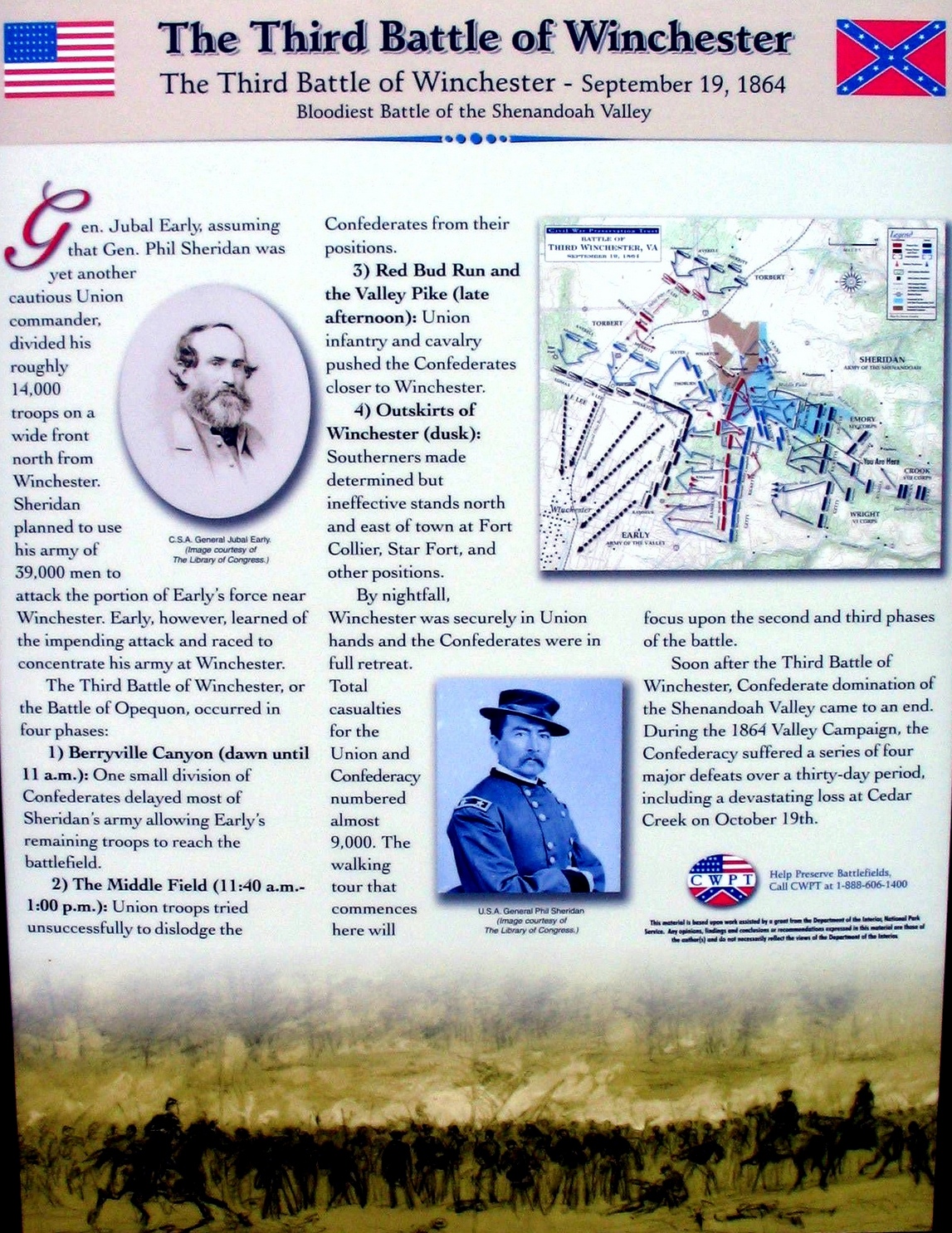
|
| 3rd Battle of Winchester, Virginia, History |
Background
Sheridan was given command of the Army of the Shenandoah and sent to the
Shenandoah Valley to deal with Early's Confederate threat. For much of the early fall of 1864, Sheridan and Early had cautiously
engaged in minor skirmishes while each side tested the other's strength. Early mistook this limited action to mean that Sheridan
was afraid to fight, and he left his army spread out from Martinsburg to Winchester. Sheridan learned of Early's dispersed
forces and immediately struck out after Winchester, the location of two previous major engagements during the war, both Confederate
victories.
Battle
The Third Battle of Winchester, commonly referred to as the Battle of Opequon,
was fought on September 19, 1864, as part of Sheridan’s Shenandoah Valley Campaign. Because of the number of men engaged,
the high casualties, and the result, Third Winchester is considered by many as the most important engagement of the 1864 Valley
Campaigns.
Maj. Gen. Philip Sheridan commanded
some 39,000 troops as he pressed the action against Lt. Gen. Jubal A. Early's smaller force of 15,000 Confederates.
Although it was a fiercely contested battle, with Sheridan pushing brigade after brigade headlong into Early's defensive position,
sheer numbers would soon overwhelm the Confederates as their lines begin to thin and fade. A Union victory it was, but not before
claiming some 5,000 Union casualties and 3,600 Confederates.
Early quickly gathered his army back together at Winchester just in time
to meet Sheridan's attack on September 19. The Union forces coming in from the east had to march on the narrow road through
Berryville Canyon, which soon got clogged up with supply wagons and troops, delaying the attack. This delay allowed Early
to further strengthen his lines. Maj. Gen. John B. Gordon's division arrived from the north and took up position on the Confederate
left.
| 3rd Battle of Winchester, Virginia |
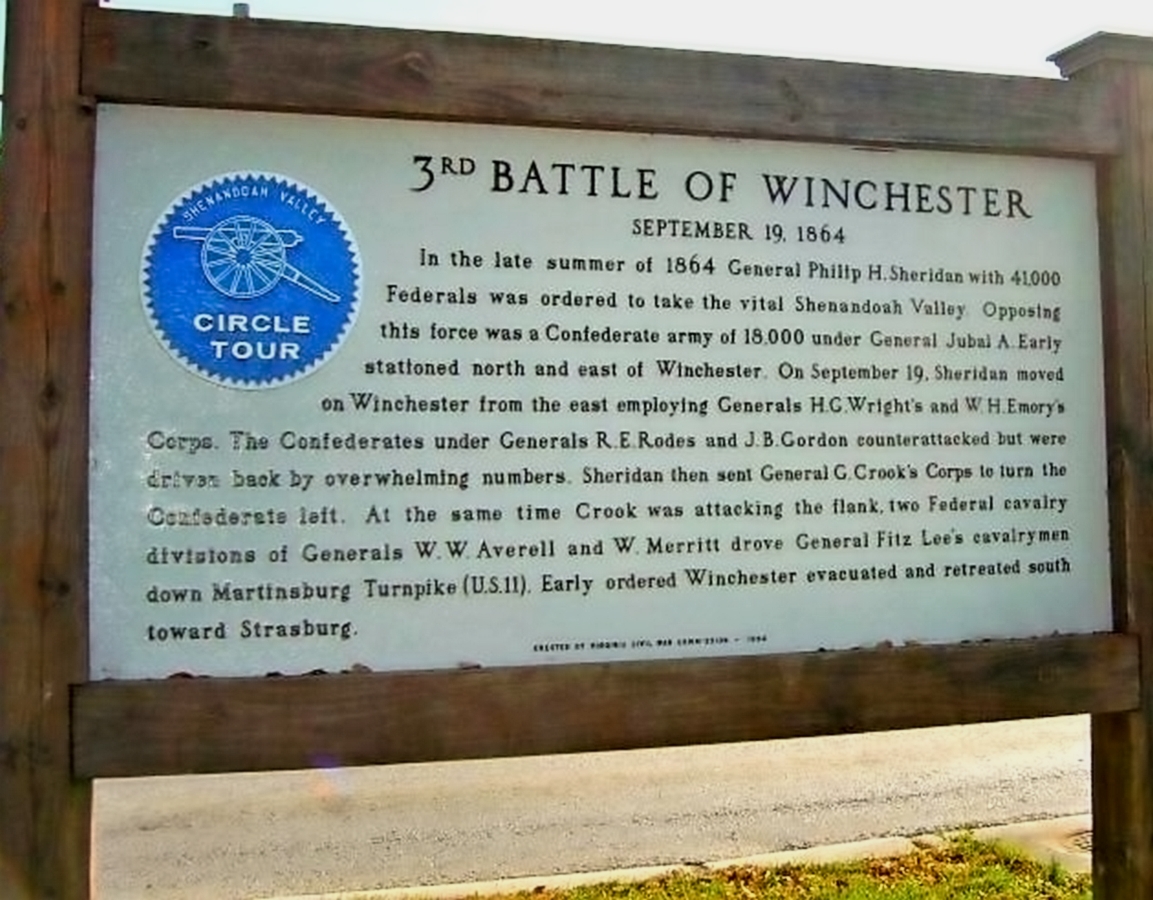
|
| Battle of Winchester Interpretive Marker |
By noon Sheridan's troops had reached the field and he ordered a frontal
attack along Early's lines. Maj. Gen. Horatio G. Wright's Union VI Corps on the left flank halted when faced with well entrenched
Confederates on a hilltop supported by artillery. The XIX Corps, under Maj. Gen. William H. Emory, to the north of the VI
Corps, drove Gordon's division through some woods, but when the Federals continued pursuing the Confederates through they
were cut down by artillery as they entered the clearing on the far side.
The VI Corps resumed its advance and began driving back the Confederate
right flank, but the VI and XIX Corps were slowly moving apart from each other and a gap appeared between them. Brig. Gen.
David A. Russell's division was rushed forward to plug the gap. Russell was hit in the chest, but continued moving his division
forward. The brigade of Brig. Gen. Emory Upton reached the gap, but was too late—the Confederates had already launched
a counterattack through the gap. Upton placed his men in line of battle and charged. Leading the charge was a young colonel
named Ranald S. Mackenzie, commanding the 2nd Connecticut Heavy Artillery regiment, serving as infantry. Russell received
a second bullet and fell mortally wounded. Upton assumed command of the division and a lull came over the battlefield.
At this point Sheridan called the battle a "splendid victory", but had no
intentions of stopping the fight just yet. Sheridan sent the VIII Corps under Brig. Gen. George Crook to find the Confederate
left flank. Meanwhile, cavalry units under Brig. Gen. James H. Wilson were swinging around the Confederate right flank. With
the three corps in line, Sheridan ordered them all forward. This new advance did not start well. Crook's troops had to march
through a swamp and the XIX Corps was not advancing at all. General Upton was struggling to persuade the XIX Corps units on
his flank to move forward with his own division when an artillery shot tore off a chunk of his thigh. The surgeon was able
to stop the bleeding and Upton ordered a stretcher brought forward from which he directed his troops for the rest of the battle.
Finally the Confederate lines began to give way. Sheridan, so excited by the imminent victory, rode along the lines waving
his hat and shouting.
| Third Battle of Winchester Civil War Map |
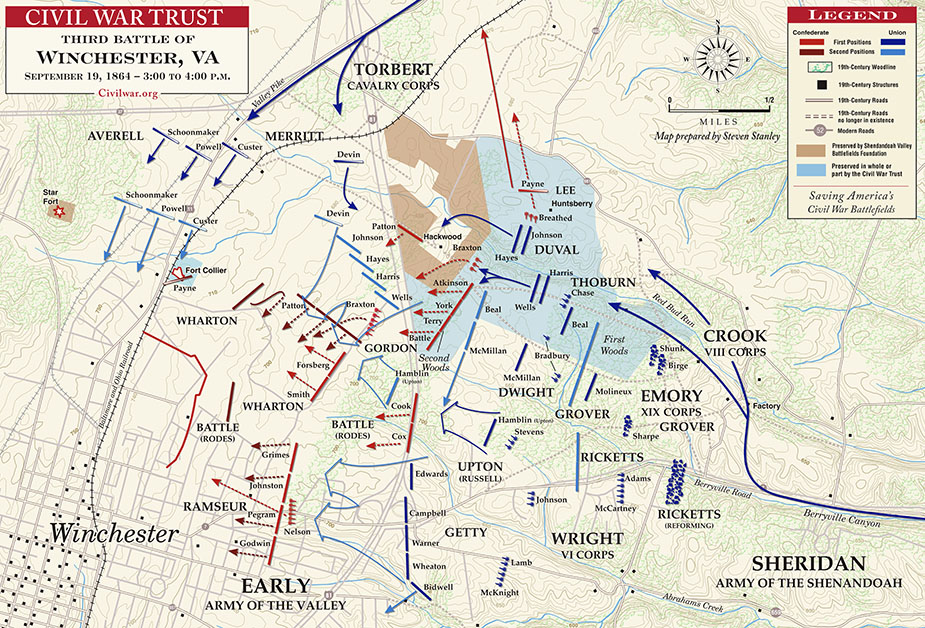
|
| 3rd Battle of Winchester, 3-4 p.m., Battlefield Action Map |
| 1864 Virginia Civil War Battlefields |
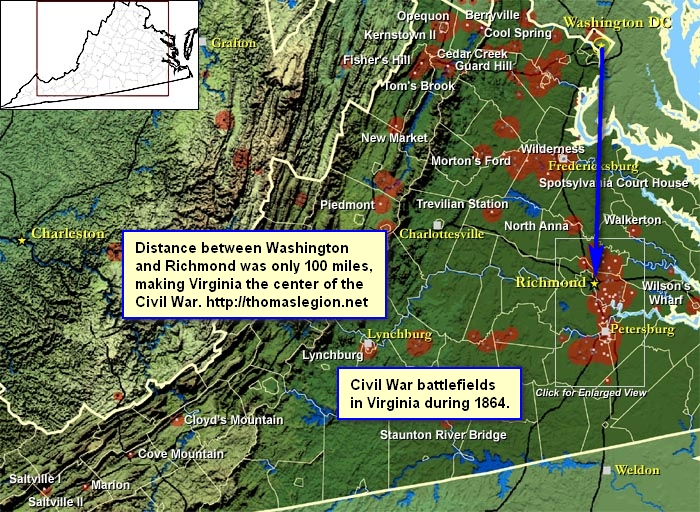
|
| 3rd Battle of Winchester Battlefield Map |
Late in the day, two divisions of Union cavalry arrived from the north and
came thundering into the Confederate left flank. The division of Brig. Gen. Wesley Merritt crushed the Confederate works while
the division of Brig. Gen. William W. Averell swung around the flank. The Confederate army was in full retreat. Caught in
the retreat were the wives of several Confederate generals staying in Winchester. John B. Gordon was forced to leave his wife
behind in attempts to keep his troops intact, believing she would become a prisoner of the Union army. She did, however, manage
to escape in time.
Analysis
Lasting more
than four murderous months and claiming some 25,000 casualties, the 1864 Shenandoah Valley Campaign is generally regarded as one of the most important campaigns of the Civil War.
After Kershaw’s division
left Winchester to rejoin Lee’s army at Petersburg, Lt. Gen. Jubal A. Early renewed his raids on the B&O
Railroad at Martinsburg, badly dispersing his four remaining infantry divisions. On September 19, Sheridan advanced toward
Winchester along the Berryville Pike with the VI and XIX Corps, crossing Opequon Creek. The Union advance was delayed long
enough for Early to concentrate his forces to meet the main assault, which continued for several hours. Casualties were very
heavy. The Confederate line was gradually driven back toward the town. Mid-afternoon, Crook’s (VIII) Corps and the cavalry
turned the Confederate left flank. Early ordered a general retreat. Confederate generals Rodes and Goodwin were killed,
Fitzhugh Lee, Terry, Johnson, and Wharton wounded. Union general Russell was killed, McIntosh, Upton, and Chapman wounded.
Because of its size, intensity, and result, many historians consider this the most important conflict of the Shenandoah Valley.
The Battle of Winchester marked a turning point in the Shenandoah Valley
in favor of the North. Early's army for the most part remained intact but suffered further defeats at Fisher's Hill and Tom's
Brook. Exactly a month later, the Valley Campaigns came to a close after Early's defeat at the Battle of Cedar Creek. Victory
in the Valley, along with other Union victories in the fall of 1864, helped win re-election for Abraham Lincoln.
The battle was particularly damaging due to the number of casualties among
key commanders. In the Union army, Brig. Gen. David A. Russell was killed and Brig. Gens. Emory Upton, George H. Chapman,
and John B. McIntosh were seriously wounded. Confederate Maj. Gen. Robert E. Rodes was killed and Maj. Gen. Fitzhugh Lee,
Brig. Gens. William Terry, Archibald Godwin, and Col. William Wharton were wounded. Also among the Confederate dead was Col.
George S. Patton, Sr. His grandson and namesake would become the famous U.S. general of World War II, George S. Patton, Jr.
| Battlefield of Winchester Map |
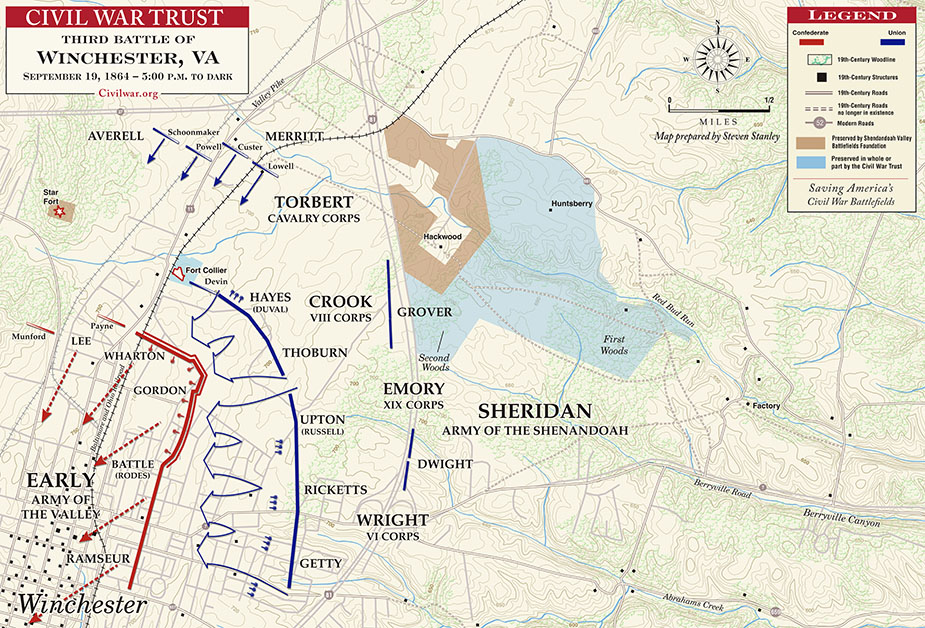
|
| 3rd Battle of Winchester and Troop Battlefield Movements at 5 p.m. |
(Sources and related reading below.)
Recommended
Reading: From Winchester to Cedar Creek:
The Shenandoah Campaign of 1864. Amazon.com
Review: Virginia's Shenandoah
Valley was a crucial avenue for Confederate armies intending to invade Northern states during the Civil
War. Running southwest to northeast, it "pointed, like a giant's lance, at the Union's heart, Washington, D.C.,"
writes Jeffry Wert. It was also "the granary of the Confederacy," supplying the food for much of Virginia. Both sides long
understood its strategic importance, but not until the fall of 1864 did Union troops led by Napoleon-sized cavalry General
Phil Sheridan (5'3", 120 lbs.) finally seize it for good. He defeated Confederate General Jubal Early at four key battles
that autumn. Continued below…
In addition
to a narrative of the campaign (featuring dozens of characters, including General George Custer and future president Rutherford
B. Hayes), this book is a study of command. Both Sheridan
and Early were capable military leaders, though each had flaws. Sheridan tended to make mistakes before battles, Early during them.
Wert considers Early the better general, but admits that few could match the real-time decision-making and leadership skills
of Sheridan
once the bullets started flying: "When Little Phil rode onto the battlefield, he entered his element." Early was a bold fighter,
but lacked the skills necessary to make up for his disadvantage in manpower. At Cedar Creek, the climactic battle of the 1864
Shenandoah campaign, Early "executed a masterful offensive against a numerically superior opponent, only to watch it result
in ruin." With more Confederate troops on the scene, history might have been different. Wert relates the facts of what actually
happened with his customary clarity and insightful analysis.
Recommended
Reading: The Official Virginia Civil War Battlefield Guide. Review: This is one of the most useful guides I've ever read.
Virginia was host to nearly one-third of all Civil War engagements,
and this guide covers them all like a mini-history of the war. Unlike travel books that are organized geographically, this
guide organizes them chronologically. Each campaign is prefaced by a detailed overview, followed by concise (from 1 to 4 pages,
depending on the battle's importance) but engrossing descriptions of the individual engagements. Continued below…
These descriptions
make this a great book to browse through when you're not in the car. Most sites' summaries touch on their condition--whether
they're threatened by development (as too many are) and whether they're in private hands or protected by the park service.
But the maps are where this book really stands out. Each battle features a very clear map designating army positions and historical
roads, as well as historical markers (the author also wrote “A Guidebook to Virginia's Historical Markers”), parking, and visitors'
centers. Best of all, though, many battles are illustrated with paintings or photographs of the sites, and the point-of-view
of these pictures is marked on each map!
Recommended
Reading: The
Shenandoah Valley Campaign of 1864 (Military Campaigns of the Civil War) (416 pages) (The University of North
Carolina Press). Description: The 1864 Shenandoah Valley Campaign
is generally regarded as one of the most important Civil War campaigns; it lasted more than four arduous months and claimed
more than 25,000 casualties. The massive armies of Generals Philip H. Sheridan and Jubal A. Early had contended for immense
stakes... Beyond the agricultural bounty and the boost in morale to be gained with its numerous battles, events in the Valley
would affect Abraham Lincoln's chances for reelection in November 1864. Continued below...
The eleven
essays in this volume reexamine common assumptions about the campaign, its major figures, and its significance. Taking advantage
of the most recent scholarship and a wide range of primary sources, contributors examine strategy and tactics, the performances
of key commanders on each side, the campaign's political repercussions, and the experiences of civilians caught in the path
of the armies. The authors do not always agree with one another, but, taken together, their essays highlight important connections
between the home front and the battlefield, as well as ways in which military affairs, civilian experiences, and politics
played off one another during the campaign.
Recommended
Reading: The
Shenandoah Valley Campaign of 1864 (McFarland & Company). Description: A
significant part of the Civil War was fought in the Shenandoah Valley of Virginia, especially in 1864. Books and articles
have been written about the fighting that took place there, but they generally cover only a small period of time and focus
on a particular battle or campaign. Continued below...
This work covers
the entire year of 1864 so that readers can clearly see how one event led to another in the Shenandoah Valley and turned once-peaceful
garden spots into gory battlefields. It tells the stories of the great leaders, ordinary men, innocent civilians, and armies
large and small taking part in battles at New Market, Chambersburg, Winchester, Fisher’s
Hill and Cedar Creek, but it primarily tells the stories of the soldiers, Union and Confederate,
who were willing to risk their lives for their beliefs. The author has made extensive use of memoirs, letters and reports
written by the soldiers of both sides who fought in the Shenandoah Valley in 1864.
Recommended Viewing: The Civil War - A Film by Ken Burns. Review: The
Civil War - A Film by Ken Burns is the most successful public-television miniseries in American history. The 11-hour Civil War didn't just captivate a nation,
reteaching to us our history in narrative terms; it actually also invented a new film language taken from its creator. When
people describe documentaries using the "Ken Burns approach," its style is understood: voice-over narrators reading letters
and documents dramatically and stating the writer's name at their conclusion, fresh live footage of places juxtaposed with
still images (photographs, paintings, maps, prints), anecdotal interviews, and romantic musical scores taken from the era
he depicts. Continued below...
The Civil War uses all of these devices to evoke atmosphere and resurrect an event that many knew
only from stale history books. While Burns is a historian, a researcher, and a documentarian, he's above all a gifted storyteller,
and it's his narrative powers that give this chronicle its beauty, overwhelming emotion, and devastating horror. Using the
words of old letters, eloquently read by a variety of celebrities, the stories of historians like Shelby Foote and rare, stained
photos, Burns allows us not only to relearn and finally understand our history, but also to feel and experience it. "Hailed
as a film masterpiece and landmark in historical storytelling." "[S]hould be a requirement for every
student."
Recommended
Reading: Shenandoah Summer: The 1864 Valley Campaign. Description: Jubal A. Early’s disastrous battles in the Shenandoah Valley
ultimately resulted in his ignominious dismissal. But Early’s lesser-known summer campaign of 1864, between his raid
on Washington and Phil Sheridan’s renowned fall campaign, had a significant impact on the political and military landscape
of the time. By focusing on military tactics and battle history in uncovering the facts and events of these little-understood
battles, Scott C. Patchan offers a new perspective on Early’s contributions to the Confederate war effort—and
to Union battle plans and politicking. Patchan details the previously unexplored battles at Rutherford’s Farm and Kernstown
(a pinnacle of Confederate operations in the Shenandoah Valley) and examines the campaign’s
influence on President Lincoln’s reelection efforts. Continued below…
He also provides
insights into the personalities, careers, and roles in Shenandoah of Confederate General John C. Breckinridge, Union general
George Crook, and Union colonel James A. Mulligan, with his “fighting Irish” brigade from Chicago. Finally, Patchan reconsiders
the ever-colorful and controversial Early himself, whose importance in the Confederate military pantheon this book at last
makes clear. About the Author: Scott C. Patchan, a Civil War battlefield guide and historian, is the author of Forgotten Fury:
The Battle of Piedmont, Virginia, and a consultant and contributing writer for Shenandoah, 1862.
Review
"The author's
descriptions of the battles are very detailed, full or regimental level actions, and individual incidents. He bases the accounts
on commendable research in manuscript collections, newspapers, published memoirs and regimental histories, and secondary works.
The words of the participants, quoted often by the author, give the narrative an immediacy. . . . A very creditable account
of a neglected period."-Jeffry D. Wert, Civil War News (Jeffry D. Wert Civil War News 20070914)
"[Shenandoah
Summer] contains excellent diagrams and maps of every battle and is recommended reading for those who have a passion for books
on the Civil War."-Waterline (Waterline 20070831)
"The narrative
is interesting and readable, with chapters of a digestible length covering many of the battles of the campaign."-Curled Up
With a Good Book (Curled Up With a Good Book 20060815)
"Shenandoah
Summer provides readers with detailed combat action, colorful character portrayals, and sound strategic analysis. Patchan''s
book succeeds in reminding readers that there is still plenty to write about when it comes to the American Civil War."-John
Deppen, Blue & Grey Magazine (John Deppen Blue & Grey Magazine 20060508)
"Scott C. Patchan
has solidified his position as the leading authority of the 1864 Shenandoah Valley Campaign with his outstanding campaign
study, Shenandoah Summer. Mr. Patchan not only unearths this vital portion of the campaign, he has brought it back to life
with a crisp and suspenseful narrative. His impeccable scholarship, confident analyses, spellbinding battle scenes, and wonderful
character portraits will captivate even the most demanding readers. Shenandoah Summer is a must read for the Civil War aficionado
as well as for students and scholars of American military history."-Gary Ecelbarger, author of "We Are in for It!": The First
Battle of Kernstown, March 23, 1862 (Gary Ecelbarger 20060903)
"Scott Patchan
has given us a definitive account of the 1864 Valley Campaign. In clear prose and vivid detail, he weaves a spellbinding narrative
that bristles with detail but never loses sight of the big picture. This is a campaign narrative of the first order."-Gordon
C. Rhea, author of The Battle of the Wilderness: May 5-6, 1864 (Gordon C. Rhea )
"[Scott Patchan]
is a `boots-on-the-ground' historian, who works not just in archives but also in the sun and the rain and tall grass. Patchan's
mastery of the topography and the battlefields of the Valley is what sets him apart and, together with his deep research,
gives his analysis of the campaign an unimpeachable authority."-William J. Miller, author of Mapping for Stonewall and Great
Maps of the Civil War (William J. Miller)
Sources: Civil War Trust @ Civilwar.org; Library of Congress; National Park
Service; National Archives; Official Records of the Union and Confederate Armies; Eicher,
David J. The Longest Night: A Military History of the Civil War. New York: Simon & Schuster, 2001. ISBN 0-684-84944-5;
Kennedy, Frances H., ed. The Civil War Battlefield Guide. 2nd ed. Boston: Houghton Mifflin Co., 1998. ISBN 0-395-74012-6;
Lewis, Thomas A., and the Editors of Time-Life Books. The Shenandoah in Flames: The Valley Campaign of 1864; Alexandria, VA:
Time-Life Books, 1987. ISBN 0-8094-4784-3; Salmon, John S. The Official Virginia Civil War Battlefield Guide. Mechanicsburg,
PA: Stackpole Books, 2001. ISBN 0-8117-2868-4; Woodworth, Steven E., and Kenneth J. Winkle. Oxford Atlas of the Civil War.
New York: Oxford University Press, 2004. ISBN 0-19-522131-1; Early, Jubal A. A Memoir of the Last Year of the War for Independence
in the Confederate States of America. Edited by Gary W. Gallagher. Columbia: University of South Carolina Press, 2001. ISBN
1-57003-450-8; Gallagher, Gary W., ed. The Shenandoah Valley Campaign of 1864. Military Campaigns of the Civil War. Chapel
Hill: University of North Carolina Press, 2006. ISBN 978-0-8078-3005-5; Gallagher, Gary W., ed. Struggle for the Shenandoah:
Essays on the 1864 Valley Campaign. Kent, OH: Kent State University Press, 1991. ISBN 0-87338-429-6; Patchan, Scott C. The
Last Battle of Winchester: Phil Sheridan, Jubal Early, and the Shenandoah Valley Campaign, August 7–September 19, 1864.
El Dorado Hills, CA: Savas Beatie, 2013. ISBN 978-1-932714-98-2; Wert, Jeffry D. From Winchester to Cedar Creek: The Shenandoah
Campaign of 1864. New York: Simon & Schuster, 1987. ISBN 0-671-67806-X; Wittenberg, Eric J. Little Phil: A Reassessment
of the Civil War Leadership of Gen. Philip H. Sheridan. Washington, DC: Potomac Books, 2002. ISBN 1-57488-548-0.
|

